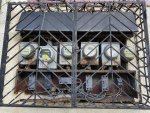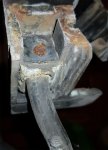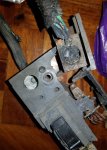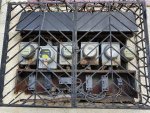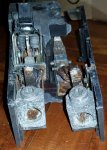You are using an out of date browser. It may not display this or other websites correctly.
You should upgrade or use an alternative browser.
You should upgrade or use an alternative browser.
What caused corrosion in these wires? water damage or joule heating, etc.?
- Thread starter tersh
- Start date
- Status
- Not open for further replies.
jaggedben
Senior Member
- Location
- Northern California
- Occupation
- Solar and Energy Storage Installer
The green is copper oxide. The black I'm not so sure but I suspect either burnt or degraded insulation, or a foreign substance that got in there and reacted with the copper.
Can you rule out that these conductors didn't simply get so hot (due perhaps to poor torquing of connections, and/or breaker not properly tripping on overcurrent) that the insulation melted, exposing the copper to extra moisture and causing corrosion?
Where I come from breakers like that usually last much longer than 20 years.
Can you rule out that these conductors didn't simply get so hot (due perhaps to poor torquing of connections, and/or breaker not properly tripping on overcurrent) that the insulation melted, exposing the copper to extra moisture and causing corrosion?
Where I come from breakers like that usually last much longer than 20 years.
LarryFine
Master Electrician Electric Contractor Richmond VA
- Location
- Henrico County, VA
- Occupation
- Electrical Contractor
I'd say the combination of water and then heat.
The green is copper oxide. The black I'm not so sure but I suspect either burnt or degraded insulation, or a foreign substance that got in there and reacted with the copper.
Can you rule out that these conductors didn't simply get so hot (due perhaps to poor torquing of connections, and/or breaker not properly tripping on overcurrent) that the insulation melted, exposing the copper to extra moisture and causing corrosion?
Where I come from breakers like that usually last much longer than 20 years.
If copper was exposed to water or moisture, how does the corrosion look like?
Imagine the wire has 20 strands. If half of the strands got corroded and no longer carry current, then the remaining strands would bear the whole load, overloading them, right?
The breaker was broken because the screws can't be removed so the electrician just used hammer to break it.
I'd say water was the main culprit. When copper began to corrode the connection became loose causing overheating.
Any copper left outdoors exposed to water will eventually oxidize and turn green.
Fun fact; If you burn it in a campfire it will cause green flames.
Any copper left outdoors exposed to water will eventually oxidize and turn green.
Fun fact; If you burn it in a campfire it will cause green flames.
KnightPower
Member
- Location
- US
I agree. From the description and the photos it appears to me as wet arc tracking. As noted, copper oxides when exposed to moisture and the "black stuff" is the breakdown of hydrocarbons found in the insulation of the wire and breaker.
Sent from my SM-G973U using Tapatalk
Sent from my SM-G973U using Tapatalk
I'd say water was the main culprit. When copper began to corrode the connection became loose causing overheating.
Any copper left outdoors exposed to water will eventually oxidize and turn green.
Fun fact; If you burn it in a campfire it will cause green flames.
Great theory. I think water from the rain reached the hole of the enclosure on top and drips into the breaker terminals at top. The bottom terminals don't have the green oxidation and wet arcing.
Just wondering. Powerlines wires use copper too and without any insulation. Why don't they corrode?
romex jockey
Senior Member
- Location
- Vermont
- Occupation
- electrician
I'm no expert tersh, but i do find heat attracts moisture , even the best sealed equipment created condensation due to it....~RJ~
ptonsparky
Tom
- Occupation
- EC - retired
From pictures you have posted in the past, first would be poor workmanship which would include installing equipment in areas they were not designed for.
kwired
Electron manager
- Location
- NE Nebraska
- Occupation
- EC
Also keep in mind you have dissimilar metals at a joint. Those metals may be fine for the joint if kept dry and tight.
Outdoor connections on POCO lines are made up with items designed for the application, the breaker terminals were not ever intended to have water involved.
Outdoor connections on POCO lines are made up with items designed for the application, the breaker terminals were not ever intended to have water involved.
kwired
Electron manager
- Location
- NE Nebraska
- Occupation
- EC
Breaker terminal in your case is probably an alloy that is mostly aluminum. White stuff is very likely aluminum oxide. Outer layer of that lug may have been some other material (maybe tin plating) but is now gone or at least full of holes.
mbrooke
Batteries Included
- Location
- United States
- Occupation
- Technician
Long over due for a complete replacement. The rest of the breakers will follow and I doubt any of them work as is.
In places like India and Thailand they will put a water proof tarp over exposed equipment or build a wooden hut to keep rain away.
In places like India and Thailand they will put a water proof tarp over exposed equipment or build a wooden hut to keep rain away.
- Location
- San Francisco Bay Area, CA, USA
- Occupation
- Electrical Engineer
That installation is totally illegal. Cost cannot be a factor in deciding to allow it to remain like this, it is a FIRE AND OR ELECTROCUTION WAITING TO HAPPEN! Breakers MUST be totally enclosed, never directly exposed to the elements like that. Most likely someone made their own distribution panel by mounting those breakers into a Raintight enclosure called a “gutter”, but it would have had a cover on it that lifted up from the bottom so that it provided a drip hood when open for servicing. Someone has removed that cover or it rusted away, leaving the breakers exposed. That is now totally illegal and extremely dangerous.
If your neighbors will not cooperate in sharing the cost for getting it fixed, make an anonymous call to the local municipality inspection dept. or Fire Marshall. Once they see it they will Red Flag it for immediate repair or replacement, with the threat of declaring your residences uninhabitable if not done.
If your neighbors will not cooperate in sharing the cost for getting it fixed, make an anonymous call to the local municipality inspection dept. or Fire Marshall. Once they see it they will Red Flag it for immediate repair or replacement, with the threat of declaring your residences uninhabitable if not done.
Last edited:
MAC702
Senior Member
- Location
- Clark County, NV
Can we assume this is in the US? It looks very typical of the type of common things I see when working in other countries. "Make it work and maybe mitigate some dangers and maintenance issues if you have time and money left over; maybe."
In Papua New Guinea, they had no local word for "maintenance." We had to teach them the concept and then they just used the English word for it.
In Papua New Guinea, they had no local word for "maintenance." We had to teach them the concept and then they just used the English word for it.
Last edited:
Cost is small factor. The major reason they can't replace the enclosure, etc, just like that is there would be two to three weeks of power interruption. Who wants 3 weeks without electricity? The reason is because the procedure to change the breakers or enclosure would be long process.
1. First. The power company has to remove all the meters. Then the electrician has to remove all the enclosure and breakers. Then
the power company would give you new meter base for installation.
2. Then you need to go to city hall to apply for electrical permit (the plan should be submitted to the power company too). It would take 5 days at most. Then the inspector will check the new meter base and new enclosure, etc. this takes long process because the inspectors are mostly busy having to serve so many places and they have to schedule it.
3. After the inspector check the service entrance panel, gutter, breakers, meter base .. One has to wait for a week before the Certificate of Electrical Inspection is released.
4. Then you have to bring the CEI to the power company which will schedule to put the meters, and electrift your home.
5. Whole process will take more than 2 weeks. Usually 3 weeks. All my neighbors don't want power interruption of 3 weeks. This is why in the
entire Philippines. We don't remodel the service entrance even if it's in the rusty condition like mine.
6. If it's only cost. I could have bought the enclosure for the neighbors and shoulder the breakers and let electrician replace all in half day. But the major problem is it would take 3 weeks of power interruption.
In the United States and other countries. What procedure do you undergo to replace the enclosure or change the breaker?
By the way.. what my electrician did replacing the breaker and wiring was not supposed to be allowed. Had he been caught. We would have power cut for litigation by the power company. I'm supposed to apply for permit first just like the above where my home would have no electricity for 3 weeks. Later I'll go to the power company to explain why the electrician did it. It usually doesn't happen like this. Any remodeling of service entrance even just replacing the breaker needs 3 weeks of permit application (enumerated above), and 3 weeks of continuous power interruption.
1. First. The power company has to remove all the meters. Then the electrician has to remove all the enclosure and breakers. Then
the power company would give you new meter base for installation.
2. Then you need to go to city hall to apply for electrical permit (the plan should be submitted to the power company too). It would take 5 days at most. Then the inspector will check the new meter base and new enclosure, etc. this takes long process because the inspectors are mostly busy having to serve so many places and they have to schedule it.
3. After the inspector check the service entrance panel, gutter, breakers, meter base .. One has to wait for a week before the Certificate of Electrical Inspection is released.
4. Then you have to bring the CEI to the power company which will schedule to put the meters, and electrift your home.
5. Whole process will take more than 2 weeks. Usually 3 weeks. All my neighbors don't want power interruption of 3 weeks. This is why in the
entire Philippines. We don't remodel the service entrance even if it's in the rusty condition like mine.
6. If it's only cost. I could have bought the enclosure for the neighbors and shoulder the breakers and let electrician replace all in half day. But the major problem is it would take 3 weeks of power interruption.
In the United States and other countries. What procedure do you undergo to replace the enclosure or change the breaker?
By the way.. what my electrician did replacing the breaker and wiring was not supposed to be allowed. Had he been caught. We would have power cut for litigation by the power company. I'm supposed to apply for permit first just like the above where my home would have no electricity for 3 weeks. Later I'll go to the power company to explain why the electrician did it. It usually doesn't happen like this. Any remodeling of service entrance even just replacing the breaker needs 3 weeks of permit application (enumerated above), and 3 weeks of continuous power interruption.
MAC702
Senior Member
- Location
- Clark County, NV
...Whole process will take more than 2 weeks. Usually 3 weeks. All my neighbors don't want power interruption of 3 weeks. This is why in the
entire Philippines. We don't remodel the service entrance even if it's in the rusty condition like mine.
6. If it's only cost. I could have bought the enclosure for the neighbors and shoulder the breakers and let electrician replace all in half day. But the major problem is it would take 3 weeks of power interruption.
In the United States and other countries. What procedure do you undergo to replace the enclosure or change the breaker?...
Ah, I thought it might be overseas. If that was in the OP, I missed it.
In the US, it seems quite normal that this is an urgent job, and the utilities and government inspection offices are ready to do this with usually only a day or two outage.
Ah, I thought it might be overseas. If that was in the OP, I missed it.
In the US, it seems quite normal that this is an urgent job, and the utilities and government inspection offices are ready to do this with usually only a day or two outage.
You can request government inspection offices to visit and issue a certificate within the day in the US?
Here in one city of 3 million population, we only have 5 inspectors (average salary per month is $250), so they have to schedule it. Processing is between one to two weeks.
I just talked with the Power company. They said it would be faster if we make a separate service entrance. Power interruption can only be days. So I guess this is the recourse we will take if I can get the neighbors to cooperate and shell some bucks (harder would be to convince each to apply for remodeling permit at city hall). Thank you all for the corrosion identification thing.
Last edited:
- Status
- Not open for further replies.



